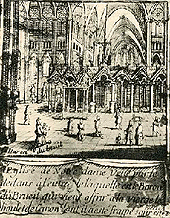
We know of 2 representations of the jube : this one and the one from Rigaut.
It’s an arched gallery. On the nave sides, seven small roofs with a sharp gable: 1 in the midle and 3 in both sides.
· The central gable, the larger one, is supported by a trefoil on 2 strong columns. Under the gable there is the great choir gate used by the canons to solemnly get in for mass.
· The 6 lateral gables are embellished by 2 trefoil bows supporting a quatrefoil rose. A column supports the bows conjuncture and 2 large columns are at the extremities.On the left of the main gate, before the first gable, is a huge canopy supported by 2 small columns. On this baldachin is the dressed statue of the Black Virgin, known now as Our Lady of the Pillar (Which should not be mistaken with the 2 representations of the Blessed Virgin). The statue was there since the beginning of the 16th century when brought by canon Vastin des Fougerais.
No one knows what was under the gallery nor above it.
Above the gables was a vertical wall or frieze, crowned by a large crucifix and the statues of the Blessed Virgin and Saint John.
Facing the choir the wall is supposed to have been sculpted. It is possible that the sculpture kept in the crypt are part of it. (polychrome sculptures dated from the du 3rd quarter of the 13th century)
According to Rouillard (1609), on both sides of the main gate, on the choir sides, were 2 freestone stairs enabling to access the 21m x 4m.stage behind the frieze and the crucifix. This is the place where were the sung the Gospels (on an eagle made of copper) on the left and Epistles (on music stand) on the right (south). Henri the 4th has been crowned there in 1594.
This jube was falling apart and taking down in 1763. (Now in Saint Martin’ Chapel in the crypt)
A new jube was built and again removed in 1869. Statues and low-relief are for a part of it kept in the bishop’s palace. The monumental iron grille serve now as gate to the Hôtel-Dieu.
Remarks : Ex-voto were hanged to the first left pillar of the great nave:
· Armours that Philippe le Bel and his son were wearing at the battle of Mons-en-Puelle.
· The wax roll known as “Tour de Ville” which was presented to “Our Lady of the Jube” by the City Mayor every year on March 15th during the 16th century.
· The cannon-ball of Baron de BueilWhen the jube has been removed, the Statue of the Virgin Mary has been moved against the ex-voto pillar. In1791, it was moved again (in the crypt) and replaced by Our Lady of Under-Ground. In1796, it was brought back. Since 1806, it is were it can be seen to day.
Last update :

